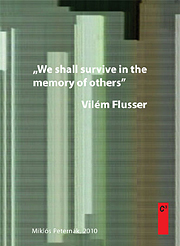This is a response I contributed to a mailing list discussion on processual art initiated by Susanne Jaschko and Lucas Evers as an extension of their exhibition Process as Paradigm. Almost all the works I refer to here were presented in that show. The catalog for the show is freely downloadable here.
As far as I have understood it, with processual art, we are in a position of referring to the contemporary condition of our civilisation having reached a point where one might almost be able to declare that it is dependent on automated processes. I think there is a central question here.
This amazingly sophisticated "life-support system" we have created with the technical arts, layer upon layer of physical and virtual infrastructure (so many, so elaborate and so diffuse that we can no longer speak of layers), which engages and traverses our individual lives in so many ways, has truly become a "Second Nature" with its own meterologies and flows, as fascinating (at least in as far as it is made manifest) as the "First Nature" we used to wonder at, and fear.
The added plus with the "Second Nature" is that we have the sense that, since we built it, we can control it.
I think Processual art addresses this situation in a few ways.
a) producing analogies (literally analog counterparts) to "Second Nature", as a kind of homage to the "Second Nature" and, simultaneously, a kind of adieu to (obsolescent notions of ) "First Nature". This position I call "Surrender". E.g.van Abbema's bacterial work (see image below), and Kudla's leaves, Boredom Research's snails.
b) producing generative models which allow our still-flesh-and-bones-and-eyes-and-ears meat-world beings to appreciate and enjoy the complexity of the "Second Nature". This is the aestheticising position of mastery and control. E.g. Sack, Rybn, Driessens & Verstappen, Schmidt and many others in the show
c) a reactionary approach which emphasises the aspects of human experience which cannot (yet) be technologized. This is somehow the position of identification with First Nature itself, integrating Humanity with all its talents and capacities as part of Nature (and more specifically terrestrial Nature)) I think of Willy Lemaitre's work here for some reason, and maybe, my own...?
d) others... (I hope these categories may be useful...)
again, if I understand it, processual art exists where we consider the interstices between First and Second Nature, between the Life Support System and good (?) old-fashioned 'Life'. Further, I would like to ask here if the process we are monitoring in processual art is that of our dehumanisation.
If we pretend to take the scientific rigour with which the machines around us are constructed so that they run so reliably and efficiently, and attempt to apply that kind of rigour to our ethics, we must contend that until there is a certifiably "fair-trade" computer there will be no legitimate critical position in technological arts.
So few people really want to go back to the old texts through which the foundations of our notion of humanity has been developed. Do we believe that our automated systems have, programmed into them, the humanism which enabled the science which created them? Are we in a position of letting automated processes determine what is better or worse for us as a species? Because we do not trust the individual position? (inherent in this is the stepping back from the claim of authorship).
This may be one of the central questions of processual art. If machines can decide better than we can, and it is only our responsibility to feed the machine enough data to process into enlightened instructions, we have invested in the mesh of automated processes, the 'life-support system, or Second Nature) all the agency we used to invest in worship. We will have become pagans in a polytheistic world of techno-magic and of mystical terror.
For our own good, and for the survival of the species, we increasingly see the convergence of, one one hand the improvement of automated processes and, on the other, the adaptation of human behaviour to be compatible with these. I am not sure if this is what Ursula Damm refers to when she describes processual art as pre-politically activist. But certainly, from a Flusserian point of view, this situation is decidedly apolitical.
















No comments:
Post a Comment